|
|
|
Sort Order |
|
|
|
Items / Page
|
|
|
|
|
|
|
| Srl | Item |
| 1 |
ID:
157950
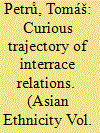

|
|
|
|
|
| Summary/Abstract |
This article aims to examine several interrelated issues pertaining to the historical development of pluralism in areas forming today´s Malaysia. Firstly, it intends to analyze the transformation of the formerly cosmopolitan populations of Malay port polities into the highly ‘racialized’ society of modern Malaysia. It also seeks to clarify the roots of ethnicity-based issues and relations in the country. Lastly, it attempts to challenge the very concept of Malaysia as a society primarily consisting of three ethnic pillars, dominated by the Malays, and ‘complemented’ by the Chinese and the Indians. I argue that the main driving force behind these tensions is the segregational colonial policies and the postcolonial arrangements of the Malay ethnocentrist governments, rather than ethnic and cultural factors as the ruling politicians tend to stress. I also contend that religious issues, especially those stemming from the dakwah movement, are gradually becoming an increasingly important factor in interrace strife.
|
|
|
|
|
|
|
|
|
|
|
|
|
|
|
|
| 2 |
ID:
093967
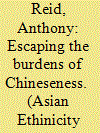

|
|
|
|
|
| Publication |
2009.
|
| Summary/Abstract |
Although Singapore currently makes it impossible in the male descent line, departing from Chineseness has been a common phenomenon in Southeast Asian history. In modern nationalist times the paucity of alternative terms in Southeast Asian and European language has made the overused Cina a problematic label, impossible to detach from a very large northern neighbour and from many cultural stereotypes. Naturally many local-born and culturally hybrid citizens have sought to escape from it. The best documented mass case is the nineteenth century Philippines. Peranakan Indonesians have not found it so easy to shed this inappropriate label even though it has occasionally been wielded as a death threat. 'Outsider' status also has its uses. This presentation will be chiefly concerned with the obstacles for Peranakan in departing from Chineseness. It will argue nevertheless that many Indonesians are quietly succeeding in taking this path.
|
|
|
|
|
|
|
|
|
|
|
|
|
|
|
|
| 3 |
ID:
086294
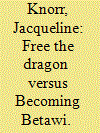

|
|
|
|
|
| Publication |
2009.
|
| Summary/Abstract |
The Chinese in Indonesia suffered considerable discrimination particularly during Suharto's rule (1967-1998). They were considered a foreign threat that needed to be kept under state control. Since the end of Suharto's regime and as a result of liberalisasi, demokratisasi and desentralisasi a revival of Chinese identity has set in, initiating a public discourse on the compatability of Chinese and Indonesian identity. This discourse refers to different categories of identification which are connected with specific conceptualizations concerning the interrelatedness of indigeneity, ethnicity and nationalism in Indonesia and Jakarta in particular.
1This paper is based on the analysis of the relevant literature concerning its theme and of the data gathered during field research in Jakarta between 2000 and 2002 and during shorter stays thereafter. Most responses and statements by informants quoted in this paper have been translated from Indonesian to English. In some cases, conversations and interviews took place in different languages besides Indonesian, namely in English, German and/or Dutch, because informants wanted to practise their foreign language knowledge.
|
|
|
|
|
|
|
|
|
|
|
|
|
|
|
|
| 4 |
ID:
190769
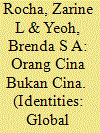

|
|
|
|
|
| Summary/Abstract |
This paper explores how being Peranakan is related to (not) being Chinese in Singapore, intertwining descent, racial categorization, cultural practice and choice. Tracing the complex history of Peranakan identity, it highlights how the social construction of race has created a hybrid yet ethnically Chinese identity, with a rich cultural heritage largely relegated to the past. Drawing on theories of racial formation and the racial state, this study illuminates racial ascription and categorization in Singapore. Interviews with 32 Peranakan individuals highlight the positioning of Peranakan identity within the multiracial framework, subsumed within the Chinese category. Examining the idea of being ‘Orang Cina Bukan Cina/Chinese but not Chinese’, the paper addresses nuances of locating the mixedness of hybridity in a racially structured context. Juxtaposed against the recent revitalization of Peranakan material culture, Peranakan as ‘locally born’ illustrates how this complex identity is used in everyday life by individuals and the state.
|
|
|
|
|
|
|
|
|
|
|
|
|
|
|
|
| 5 |
ID:
187167
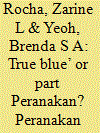

|
|
|
|
|
| Summary/Abstract |
While no longer associated with colonial economic and political privilege, Peranakan Chinese identity is now often viewed as an ‘authentic’ heritage in contemporary Singapore that is made visible through hybrid cultural and material markers. But for the Peranakan community, what does it mean to be authentically Peranakan in post-colonial Singapore? This paper explores concepts of hybridity and authenticity for Peranakan individuals, highlighting how being Peranakan is informed by ideas of belonging, mixedness and purity, from being ‘true blue’ to generational shifts towards being part Peranakan. Drawing on critical mixed race theory, the paper provides an historical overview of Peranakan identity in the region, tracing how ‘authentic’ Peranakan-ness has changed over time. Using a series of narrative interviews with self-identified Peranakan individuals across three generations, the paper explores public and private representations of identity, and how mixedness and purity are seen as being ‘authentic’ aspects of Peranakan culture.
|
|
|
|
|
|
|
|
|
|
|
|
|
|
|
|
|
|
|
|
|